
Zahara Green is lucky to be alive.
Green, a 25-year-old transgender inmate recently released from Rogers State Prison just outside of Savannah, Ga., has filed suit against that state alleging that while incarcerated, she was repeatedly sexually assaulted by another inmate.
But it doesn’t end there. Appallingly, her suit alleges that when she requested protective custody – which would have consisted of removing her from the general population and putting her in a private cell by herself – she found herself instead locked alone in a cell with that same assailant for almost 24 hours.
While only about .3 percent of the population identify as transgender and 3.5 percent of the populace identifies as gay or lesbian, it is interesting – and important – to note that transgender individuals are targeted for violent crimes at much higher rates than their LGB “cousins.”
Transgender people are a full 50 percent more likely to be murdered than gays or lesbians. According to transgenderlaw.org, from 1985 to 1998, transgender victims accounted for a full 20 percent of murders in the U.S. and 40 percent of police-initiated violence.
They are shot, stabbed, beaten to death, drowned, set on fire, or, as happened to Cleveland’s Cemia “CeCe” Dove and Milwaukee’s Evon Young last year, a horrifying combination of the above – and then some.
Trans people are 13 times more likely to be targeted for sexual abuse. Male-to-female trans people are more likely to suffer all forms of assault than female-to-males, and trans women of color are 70 percent more likely to be targeted than anyone else in the trans spectrum.
According to a 2013 U.S. Department of Justice report, the Bureau of Justice Statistics shows that for 2011-2012, 12.8 percent of non-heterosexual inmates reported sexual abuse at the hands of other prisoners or staff, while only 2.9 percent of heterosexual inmates were victimized. An empirical study conducted in California in 2009 of transgender inmates in that state found that 58.5 percent of them had experienced sexual assaults while incarcerated.
The federal government has a responsibility to protect inmates from sexual assault under the 2003 Prison Rape Elimination Act (PREA). Pursuant legislation in 2012 added that agencies cannot place an inmate in a given facility purely due to their “genital status.” Management and security problems are to be considered on a case-by-case basis, and the most important factor to be weighed in is the prisoner’s own safety – taking into consideration both their actual risk and their own personal concerns.
Green had been transitioning since the age of 17. She was on hormones. She was quite obviously female. She had been busted for shoplifting, and then she was dumped off in the general population upon her arrival at Rogers – a men’s prison.
At that point, Green became targeted by inmate Darryl Ricard – a child molester, rapist, and high-ranking gang member serving a life sentence – who sexually assaulted her a number of times. Green began writing to prison officials about her safety concerns. Eventually, she obtained protective custody for herself, and that’s when this story gets even worse.
Somehow or another, Ricard, for reasons that remain unclear, just “happened” to end up in protective custody the same day. And somehow or another, Ricard just “happened” to end up in Green’s cell – where he was waiting for her when she got there.
Now, let’s give this situation some serious contemplation. Wait – no, let’s not, because there’s really no need. This situation has neon lights and flags all over it that don’t require contemplation at all. When you hear shooting going on, you don’t stand there and think about it, you duck and run for cover.
By the same token, when you have an inmate in a cell that belongs to another inmate who is supposed to be housed alone in protective custody, you don’t think about it. You keep your inmate away from him and find out who the other one is and what he’s doing there.
Apparently, however, what is lightning-bolt obvious to the rest of us is not so obvious to Georgian corrections officers because upon finding Ricard in Green’s cell, they put her in it with him anyway. Beyond that, they ignored outright a prison rule requiring guards to check in on inmates in protective custody every thirty minutes. Instead of doing their jobs, Green’s lawsuit alleges, they dumped her off alone in a cell with her rapist and didn’t bother to check on her again – at all – for almost 24 hours.
Perhaps needless to say, during that 24-hour period, Green was raped by her assailant. Green’s attorney, Mario Williams, filed two separate complaints against the prison’s warden, deputy warden, and a total of 15 corrections officers for what he referred to as “official misconduct.”
“Ricard raped Green, and the Defendants to this action all knew Ricard was going to rape (or at the very least, sexually assault) Green yet permitted [it to happen],” Williams said in one of the complaints.
The question is, why? Was it trans hate that motivated the guards’ collective and apparently deliberate efforts to allow Green to be assaulted? Was it gang member Ricard’s ability to pull strings to get himself placed in the right place at the right time to get at his victim? Was it, more likely, a combination of the above, a concerted effort of hatred held by an entire group of people against one individual they didn’t even know, but clearly felt like they weren’t morally obligated to care about?
If what Green says happened to her at Rogers is true, then misconduct is a light way to describe what happened here – the ignorance, dissonance and apathy involved in this case, to say nothing of hatred – and the fact that it was allegedly part of a breakdown of responsibility that spanned across an entire group of guards and officials is downright asinine.
What is also concerning is that no one seems to be talking about it, and officials are trying to pretend it didn’t happen. Lack of media coverage may help them do that – a Google search of the incident turns up four or five references to it and most of those are just the same article posted on different sites.
The attorneys for the defense claim steadfastly that no one knew Ricard had been assaulting Green in the first place, even though Green contacted the prison and so did her mother. In the defendants’ attorneys’ response to the case, Green is consistently referred to as “he,” a deliberate disrespect to Green and a way of further trying to put it into people’s heads that this victim is confused, mentally disturbed and simply cannot be taken seriously.
All of these things – the assaults, the guards’ complicity, the attempts to downplay the alleged events – defy logic, reason and common decency.
Considering the statistics, Zahara Green is lucky to be alive. But it should take more than luck to preserve a human being’s right to stay that way while incarcerated.







